oil filter Seat Exeo 2009 Owner's manual
[x] Cancel search | Manufacturer: SEAT, Model Year: 2009, Model line: Exeo, Model: Seat Exeo 2009Pages: 310, PDF Size: 8.54 MB
Page 81 of 310
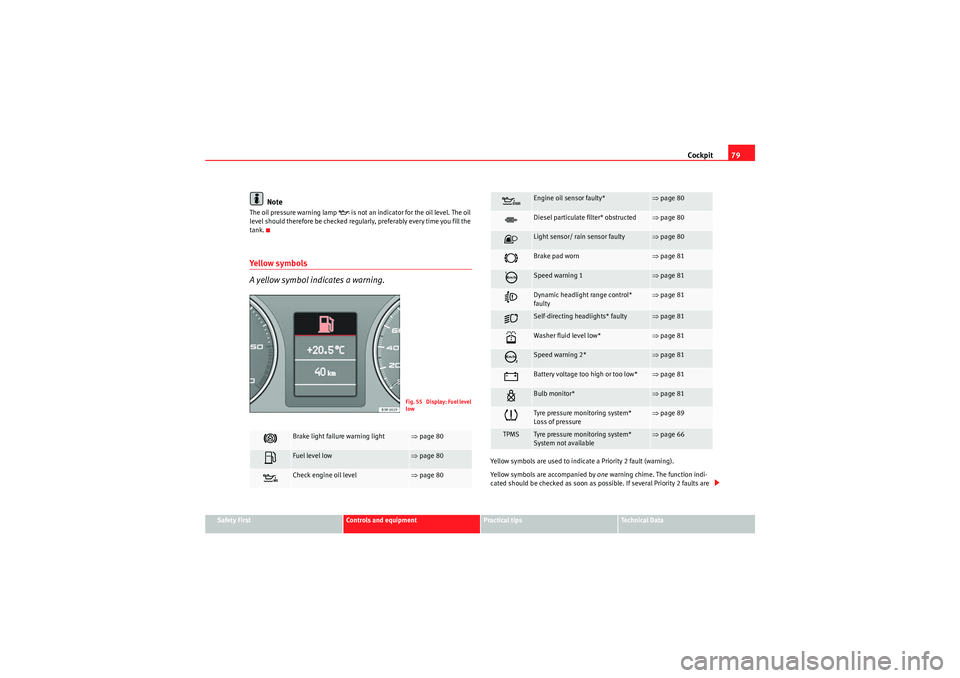
Cockpit79
Safety First
Controls and equipment
Practical tips
Technical Data
Note
The oil pressure warning lamp
is not an indicator for the oil level. The oil
level should therefore be checked regularly, preferably every time you fill the
tank.
Ye ll o w s y m b o l s
A yellow symbol indicates a warning.
Yellow symbols are used to indicate a Priority 2 fault (warning).
Yellow symbols are accompanied by one warning chime. The function indi-
cated should be checked as soon as possible. If several Priority 2 faults are
Brake light failure warning light
⇒ page 80
Fuel level low
⇒page 80
Check engine oil level
⇒page 80F i g . 5 5 D i s p l a y : F u e l l e v e l
low
Engine oil sensor faulty*
⇒page 80
Diesel particulate filter* obstructed
⇒page 80
Light sensor/ rain sensor faulty
⇒page 80
Brake pad worn
⇒page 81
Speed warning 1
⇒page 81
Dynamic headlight range control*
faulty
⇒page 81
Self-directing headlights* faulty
⇒page 81
Washer fluid level low*
⇒page 81
Speed warning 2*
⇒page 81
Battery voltage too high or too low*
⇒page 81
Bulb monitor*
⇒page 81
Tyre pressure monitoring system*
Loss of pressure
⇒page 89
TPMS
Tyre pressure monitoring system*
System not available
⇒page 66
Exeo_EN.book Seite 79 Freitag, 28. August 2009 10:14 10
Page 82 of 310
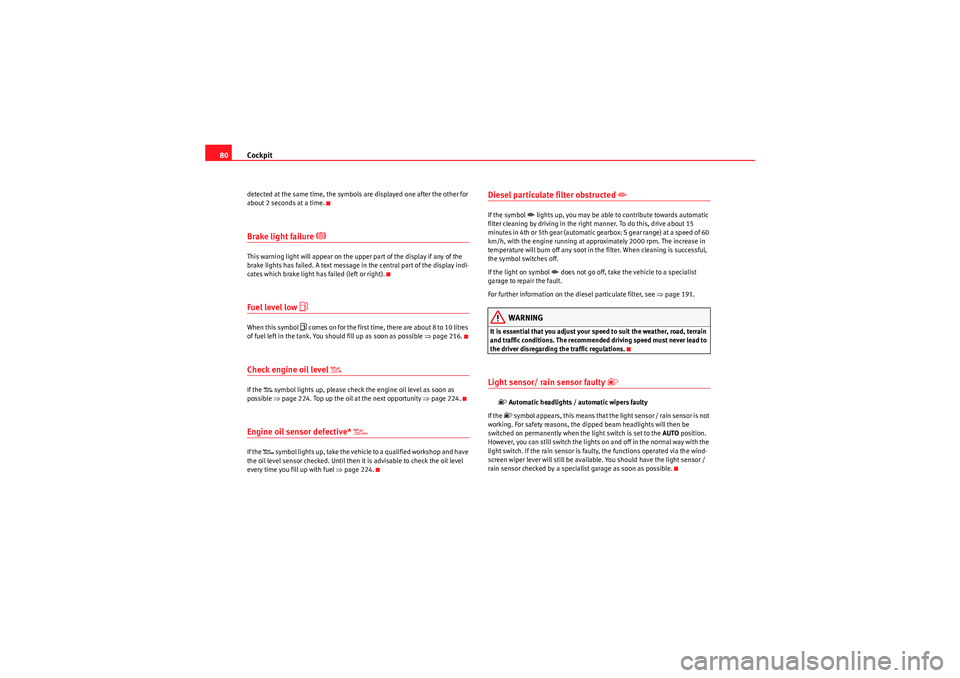
Cockpit
80detected at the same time, the symbol s are displayed one after the other for
about 2 seconds at a time.Brake light failure
This warning light will appear on the upper part of the display if any of the
brake lights has failed. A text message in the central part of the display indi-
cates which brake light has failed (left or right).Fuel level low
When this symbol
comes on for the first time, there are about 8 to 10 litres
of fuel left in the tank. You should fill up as soon as possible ⇒page 216.
Check engine oil level
If the
symbol lights up, please check the engine oil level as soon as
possible ⇒page 224. Top up the oil at the next opportunity ⇒page 224.
Engine oil sensor defective*
If the
symbol lights up, take the vehicle to a qualified workshop and have
the oil level sensor checked. Until then it is advisable to check the oil level
every time you fill up with fuel ⇒page 224.
Diesel particulate filter obstructed
If the symbol
lights up, you may be able to contribute towards automatic
filter cleaning by driving in the right manner. To do this, drive about 15
minutes in 4th or 5th gear (automatic gearbox: S gear range) at a speed of 60
km/h, with the engine running at approximately 2000 rpm. The increase in
temperature will burn off any soot in the filter. When cleaning is successful,
the symbol switches off.
If the light on symbol
does not go off, take the vehicle to a specialist
garage to repair the fault.
For further information on the diesel particulate filter, see ⇒page 191.
WARNING
It is essential that you adjust your speed to suit the weather, road, terrain
and traffic conditions. The recommended driving speed must never lead to
the driver disregarding the traffic regulations.Light sensor/ rain sensor faulty
Automatic headlights / automatic wipers faulty
If the symbol appears, this means that the light sensor / rain sensor is not
working. For safety reasons, the dipped beam headlights will then be
switched on permanently when the light switch is set to the AUTO position.
However, you can still switch the lights on and off in the normal way with the
light switch. If the rain sensor is faulty, the functions operated via the wind-
screen wiper lever will still be available. You should have the light sensor /
rain sensor checked by a specialist garage as soon as possible.
Exeo_EN.book Seite 80 Freitag, 28. August 2009 10:14 10
Page 208 of 310
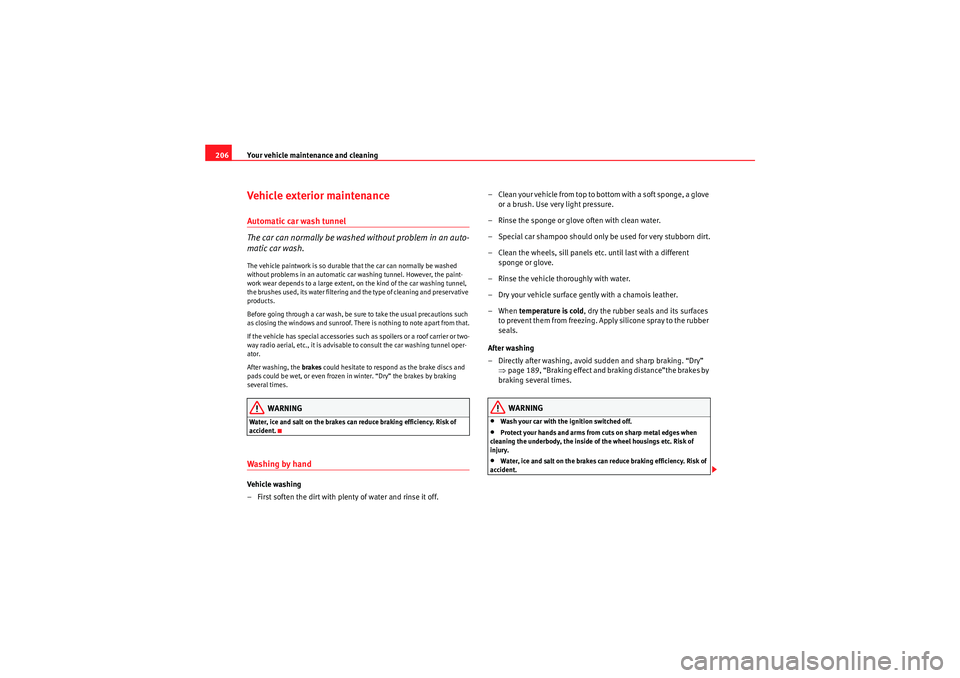
Your vehicle maintenance and cleaning
206Vehicle exterior maintenanceAutomatic car wash tunnel
The car can normally be washed without problem in an auto-
matic car wash.The vehicle paintwork is so durable that the car can normally be washed
without problems in an automatic car washing tunnel. However, the paint-
work wear depends to a large extent, on the kind of the car washing tunnel,
the brushes used, its water filtering and the type of cleaning and preservative
products.
Before going through a car wash, be sure to take the usual precautions such
as closing the windows and sunroof. There is nothing to note apart from that.
If the vehicle has special accessories such as spoilers or a roof carrier or two-
way radio aerial, etc., it is advisable to consult the car washing tunnel oper-
ator.
After washing, the brakes could hesitate to respond as the brake discs and
pads could be wet, or even frozen in winter. “Dry” the brakes by braking
several times.
WARNING
Water, ice and salt on the brakes can reduce braking efficiency. Risk of
accident.Washing by handVehicle washing
– First soften the dirt with plenty of water and rinse it off. – Clean your vehicle from top to bottom with a soft sponge, a glove
or a brush. Use very light pressure.
– Rinse the sponge or glove often with clean water.
– Special car shampoo should only be used for very stubborn dirt.
– Clean the wheels, sill panels etc. until last with a different sponge or glove.
– Rinse the vehicle thoroughly with water.
– Dry your vehicle surface gently with a chamois leather.
–When temperature is cold , dry the rubber seals and its surfaces
to prevent them from freezing. Apply silicone spray to the rubber
seals.
After washing
– Directly after washing, avoid sudden and sharp braking. “Dry” ⇒page 189, “Braking effect and braking distance”the brakes by
braking several times.
WARNING
•Wash your car with the ignition switched off.•Protect your hands and arms from cuts on sharp metal edges when
cleaning the underbody, the inside of the wheel housings etc. Risk of
injury.•Water, ice and salt on the brakes can reduce braking efficiency. Risk of
accident.
Exeo_EN.book Seite 206 Freitag, 28. August 2009 10:14 10
Page 224 of 310
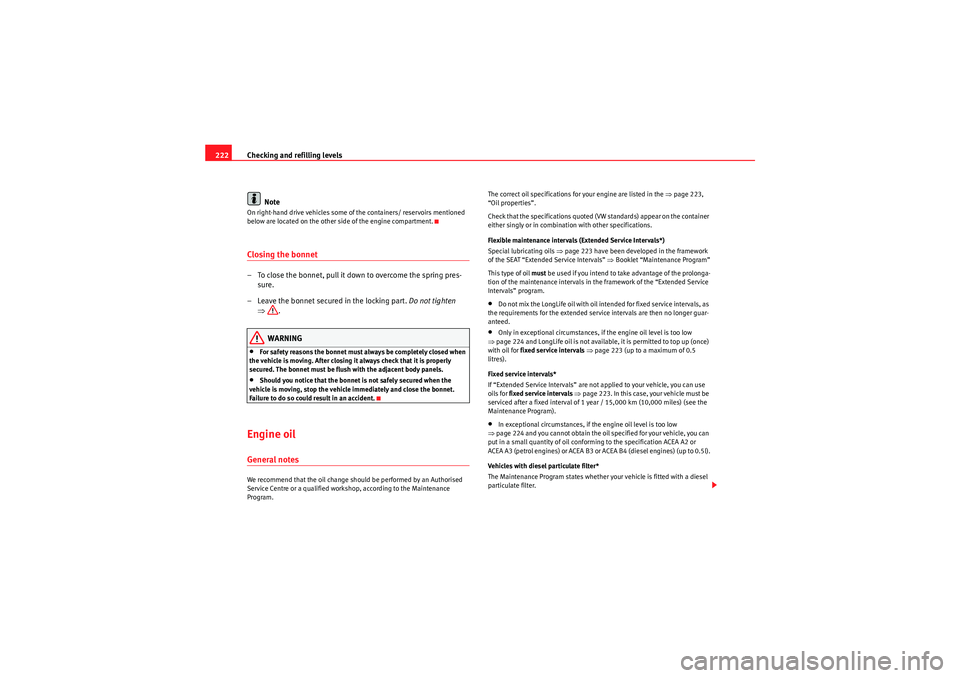
Checking and refilling levels
222
NoteOn right-hand drive vehicles some of the containers/ reservoirs mentioned
below are located on the other side of the engine compartment.Closing the bonnet– To close the bonnet, pull it down to overcome the spring pres- sure.
– Leave the bonnet secured in the locking part. Do not tighten
⇒ .
WARNING
•For safety reasons the bonnet must always be completely closed when
the vehicle is moving. After closing it always check that it is properly
secured. The bonnet must be flush with the adjacent body panels.•Should you notice that the bonnet is not safely secured when the
vehicle is moving, stop the vehicle immediately and close the bonnet.
Failure to do so could result in an accident.
Engine oilGeneral notesWe recommend that the oil change should be performed by an Authorised
Service Centre or a qualified workshop, according to the Maintenance
Program. The correct oil specifications for your engine are listed in the
⇒page 223,
“Oil properties”.
Check that the specifications quoted (VW standards) appear on the container
either singly or in combination with other specifications.
Flexible maintenance intervals (Extended Service Intervals*)
Special lubricating oils ⇒page 223 have been developed in the framework
of the SEAT “Extended Service Intervals” ⇒Booklet “Maintenance Program”
This type of oil must be used if you intend to take advantage of the prolonga-
tion of the maintenance intervals in the framework of the “Extended Service
Intervals” program.
•Do not mix the LongLife oil with oil intended for fixed service intervals, as
the requirements for the extended service intervals are then no longer guar-
anteed.•Only in exceptional circumstances, if the engine oil level is too low
⇒ page 224 and LongLife oil is not available, it is permitted to top up (once)
with oil for fixed service intervals ⇒ page 223 (up to a maximum of 0.5
litres).
Fixed service intervals*
If “Extended Service Intervals” are not applied to your vehicle, you can use
oils for fixed service intervals ⇒ page 223. In this case, your vehicle must be
serviced after a fixed interval of 1 year / 15,000 km (10,000 miles) (see the
Maintenance Program).•In exceptional circumstances, if the engine oil level is too low
⇒ page 224 and you cannot obtain the oil specified for your vehicle, you can
put in a small quantity of oil conforming to the specification ACEA A2 or
ACEA A3 (petrol engines) or ACEA B3 or ACEA B4 (diesel engines) (up to 0.5l).
Vehicles with diesel particulate filter*
The Maintenance Program states whether your vehicle is fitted with a diesel
particulate filter.
Exeo_EN.book Seite 222 Freitag, 28. August 2009 10:14 10
Page 225 of 310
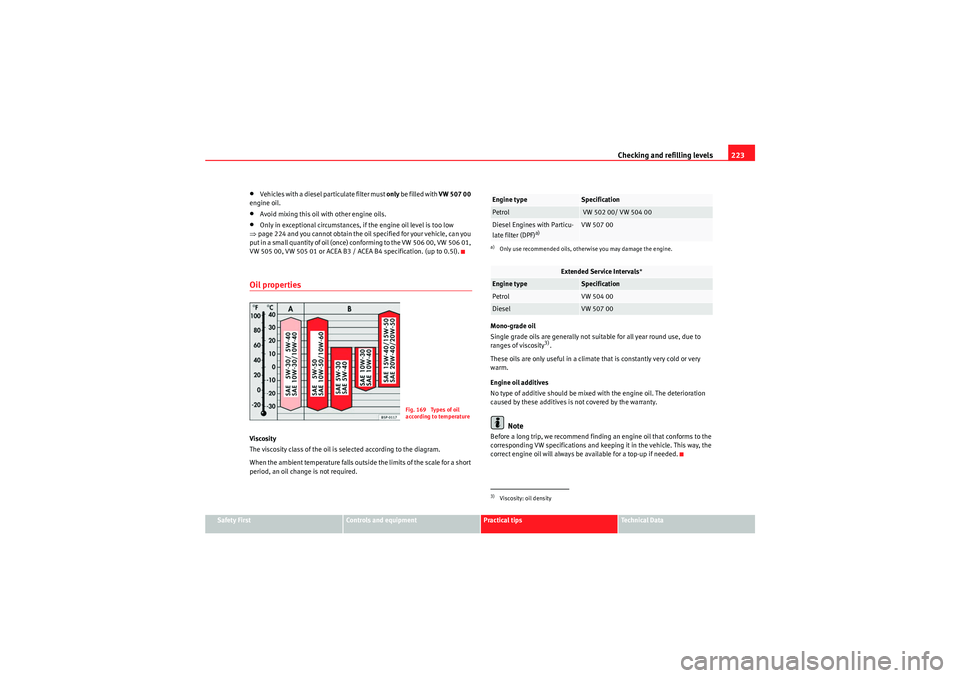
Checking and refilling levels223
Safety First
Controls and equipment
Practical tips
Technical Data
•Vehicles with a diesel particulate filter must only b e fille d with VW 507 00
engine oil.•Avoid mixing this oil with other engine oils.•Only in exceptional circumstances, if the engine oil level is too low
⇒ page 224 and you cannot obtain the oil specified for your vehicle, can you
put in a small quantity of oil (once) conforming to the VW 506 00, VW 506 01,
VW 505 00, VW 505 01 or ACEA B3 / ACEA B4 specification. (up to 0.5l).Oil propertiesViscosity
The viscosity class of the oil is selected according to the diagram.
When the ambient temperature falls outside the limits of the scale for a short
period, an oil change is not required. Mono-grade oil
Single grade oils are generally not suitable for all year round use, due to
ranges of viscosity
3).
These oils are only useful in a climate that is constantly very cold or very
warm.
Engine oil additives
No type of additive should be mixed with the engine oil. The deterioration
caused by these additives is not covered by the warranty.
Note
Before a long trip, we recommend finding an engine oil that conforms to the
corresponding VW specifications and keeping it in the vehicle. This way, the
correct engine oil will always be available for a top-up if needed.
Fig. 169 Types of oil
according to temperature
Engine type
Specification
Petrol
VW 502 00/ VW 504 00
Diesel Engines with Particu-
late filter (DPF)
a)
a)Only use recommended oils, otherwise you may damage the engine.
VW 507 00
Extended Service Intervals *
Engine type
Specification
Petrol
VW 504 00
Diesel
VW 507 00
3)Viscosity: oil density
Exeo_EN.book Seite 223 Freitag, 28. August 2009 10:14 10
Page 293 of 310
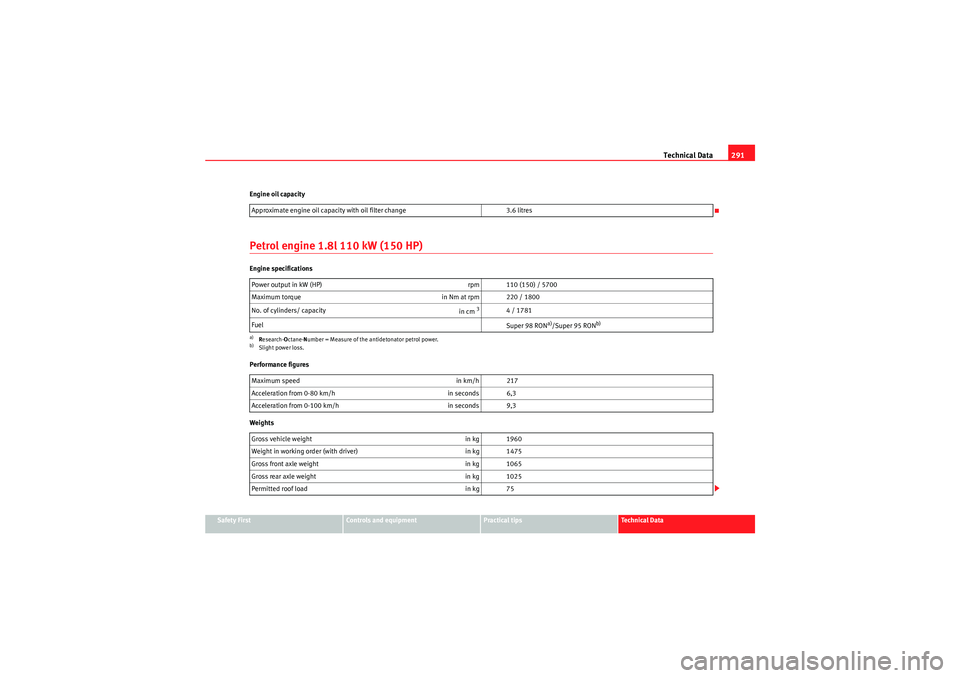
Technical Data291
Safety First
Controls and equipment
Practical tips
Technical Data
Engine oil capacity
Petrol engine 1.8l 110 kW (150 HP)Engine specifications
Performance figures
Weights
Approximate engine oil capacity with oil filter change
3.6 litres
Power output in kW (HP) rpm 110 (150) / 5700
Maximum torque in Nm at rpm 220 / 1800
No. of cylinders/ capacity in cm
3
4 / 1781
Fuel Super 98 RON
a)/Super 95 RON
b)
a)Research- Octane- Number = Measure of the antidetonator petrol power.b)Slight power loss.Maximum speed in km/h 217
Acceleration from 0-80 km/h in seconds 6,3
Acceleration from 0-100 km/h in seconds 9,3
Gross vehicle weight in kg 1960
Weight in working order (with driver) in kg 1475
Gross front axle weight in kg 1065
Gross rear axle weight in kg 1025
Permitted roof load in kg 75
Exeo_EN.book Seite 291 Freitag, 28. August 2009 10:14 10
Page 294 of 310
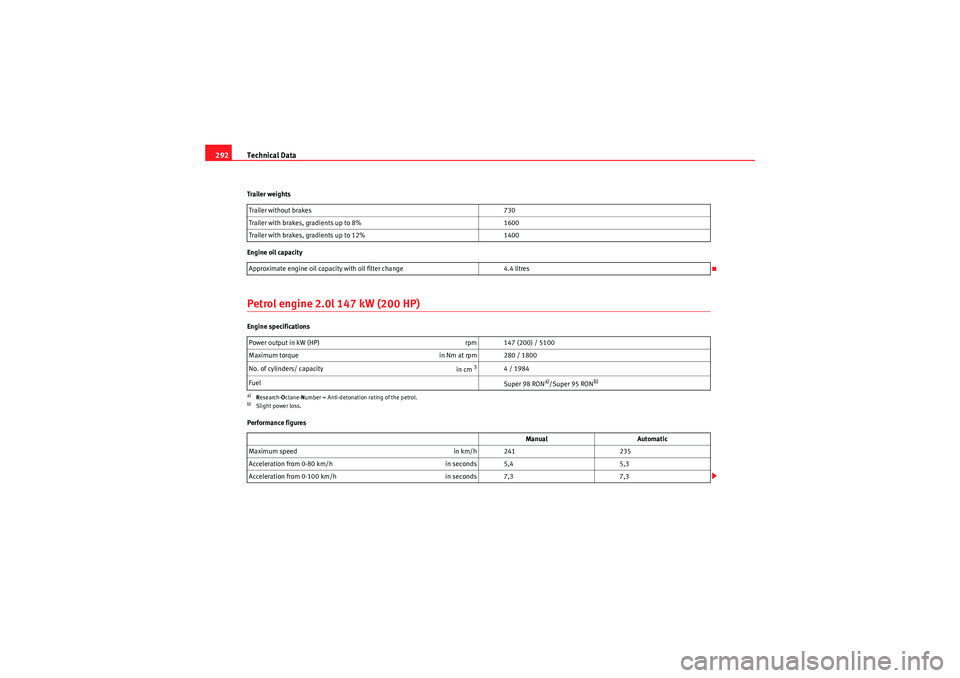
Technical Data
292Trailer weights
Engine oil capacityPetrol engine 2.0l 147 kW (200 HP)Engine specifications
Performance figures Trailer without brakes
730
Trailer with brakes, gradients up to 8% 1600
Trailer with brakes, gradients up to 12% 1400
Approximate engine oil capacity with oil filter change 4.4 litres
Power output in kW (HP) rpm 147 (200) / 5100
Maximum torque in Nm at rpm 280 / 1800
No. of cylinders/ capacity in cm
3
4 / 1984
Fuel Super 98 RON
a)/Super 95 RON
b)
a)Research- Octane- Number = Anti-detonation rating of the petrol.b)Slight power loss.
Manual Automatic
Maximum speed in km/h 241235
Acceleration from 0-80 km/h in seconds 5,45,3
Acceleration from 0-100 km/h in seconds 7,37,3
Exeo_EN.book Seite 292 Freitag, 28. August 2009 10:14 10
Page 295 of 310
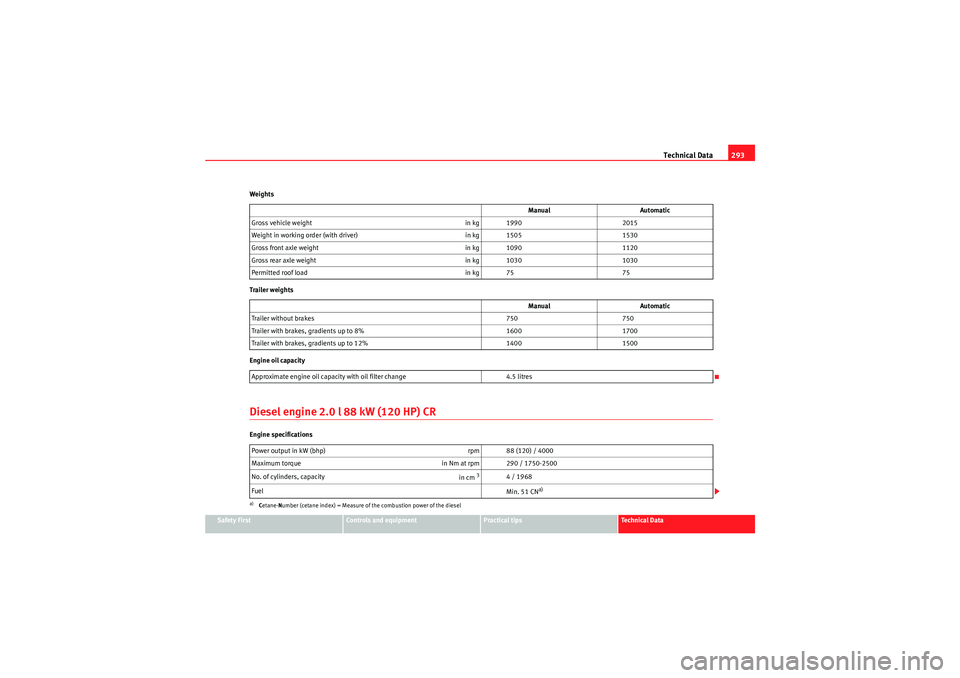
Technical Data293
Safety First
Controls and equipment
Practical tips
Technical Data
Weights
Trailer weights
Engine oil capacity
Diesel engine 2.0 l 88 kW (120 HP) CREngine specifications
Manual
Automatic
Gross vehicle weight in kg 19902015
Weight in working order (with driver) in kg 15051530
Gross front axle weight in kg 10901120
Gross rear axle weight in kg 10301030
Permitted roof load in kg 7575
Manual Automatic
Trailer without brakes 750750
Trailer with brakes, gradients up to 8% 16001700
Trailer with brakes, gradients up to 12% 14001500
Approximate engine oil capacity with oil filter change 4.5 litres
Power output in kW (bhp) rpm 88 (120) / 4000
Maximum torque in Nm at rpm 290 / 1750-2500
No. of cylinders, capacity in cm
3
4 / 1968
Fuel Min. 51 CN
a)
a)Cetane- Number (cetane index) = Measure of the combustion power of the diesel
Exeo_EN.book Seite 293 Freitag, 28. August 2009 10:14 10
Page 296 of 310
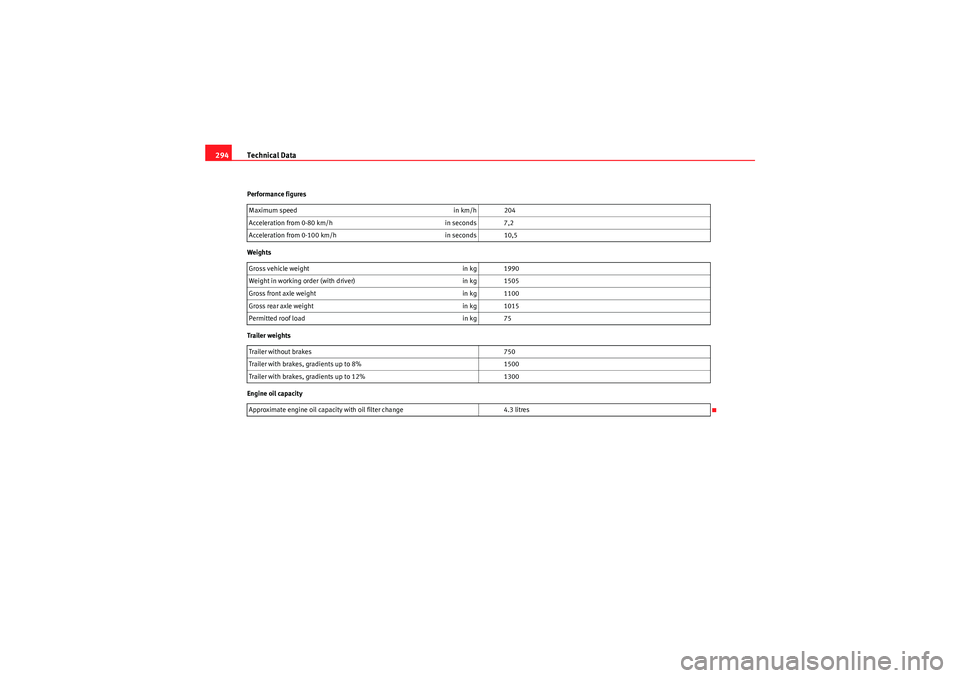
Technical Data
294Performance figures
Weights
Trailer weights
Engine oil capacity Maximum speed
in km/h 204
Acceleration from 0-80 km/h in seconds 7,2
Acceleration from 0-100 km/h in seconds 10,5
Gross vehicle weight in kg 1990
Weight in working order (with driver) in kg 1505
Gross front axle weight in kg 1100
Gross rear axle weight in kg 1015
Permitted roof load in kg 75
Trailer without brakes 750
Trailer with brakes, gradients up to 8% 1500
Trailer with brakes, gradients up to 12% 1300
Approximate engine oil capacity with oil filter change 4.3 litres
Exeo_EN.book Seite 294 Freitag, 28. August 2009 10:14 10
Page 298 of 310
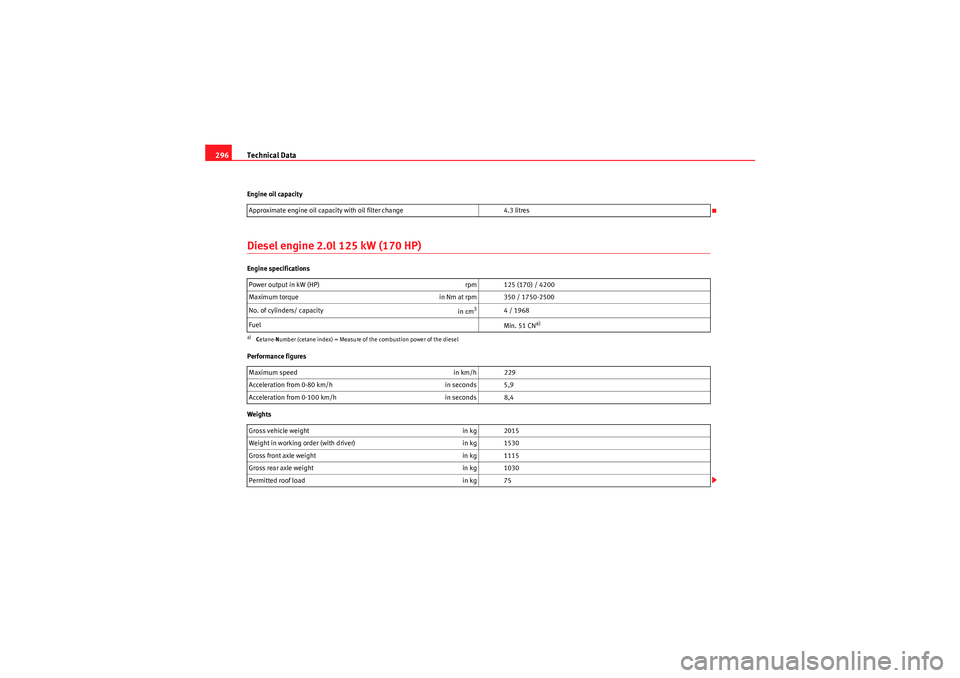
Technical Data
296Engine oil capacityDiesel engine 2.0l 125 kW (170 HP)Engine specifications
Performance figures
Weights Approximate engine oil capacity with oil filter change
4.3 litres
Power output in kW (HP) rpm 125 (170) / 4200
Maximum torque in Nm at rpm 350 / 1750-2500
No. of cylinders/ capacity in cm
3
4 / 1968
Fuel Min. 51 CN
a)
a)Cetane- Number (cetane index) = Measure of the combustion power of the dieselMaximum speed in km/h 229
Acceleration from 0-80 km/h in seconds 5,9
Acceleration from 0-100 km/h in seconds 8,4
Gross vehicle weight in kg 2015
Weight in working order (with driver) in kg 1530
Gross front axle weight in kg 1115
Gross rear axle weight in kg 1030
Permitted roof load in kg 75
Exeo_EN.book Seite 296 Freitag, 28. August 2009 10:14 10